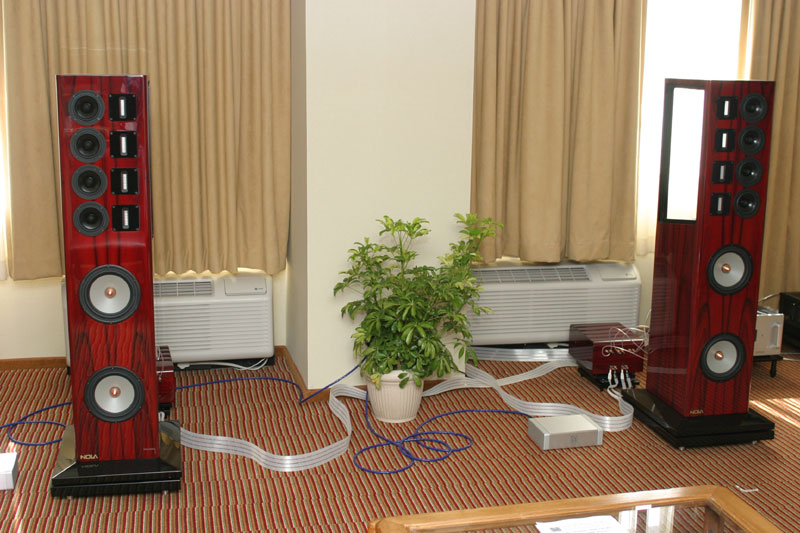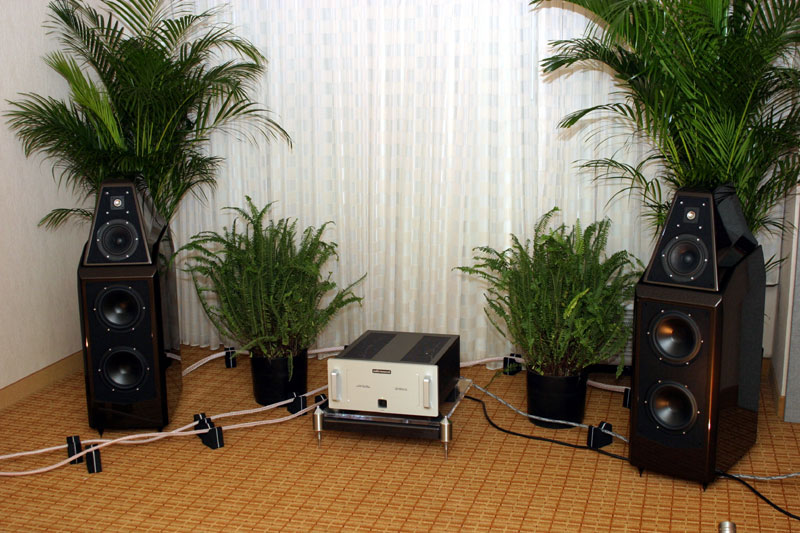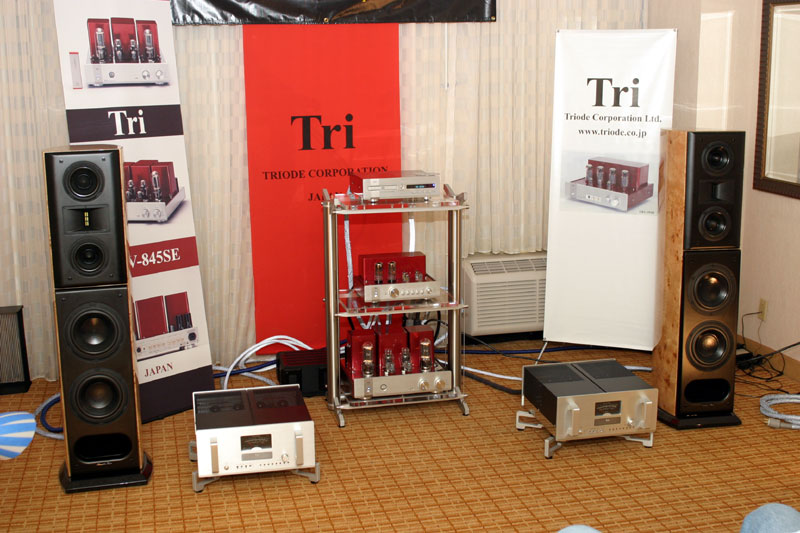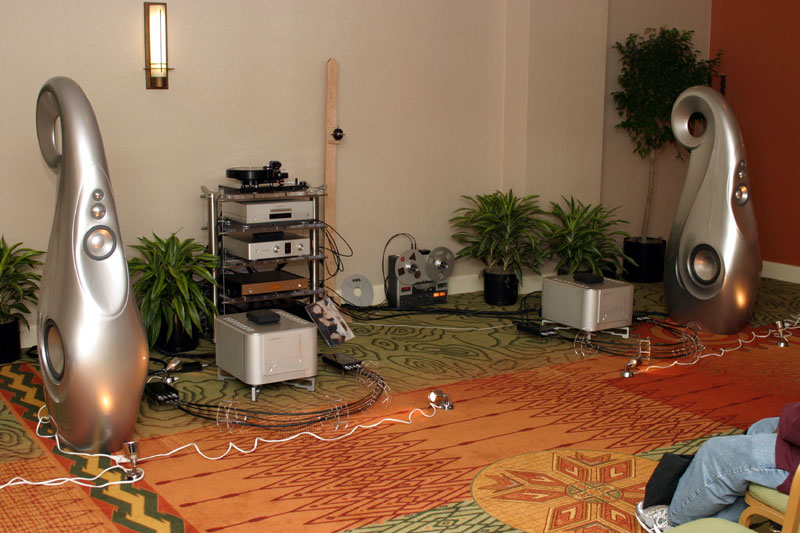Two-Channelin' at the Rocky Mountain Audio Fest
hanks to my Thursday-night flight from Minneapolis to Denver being cancelled, apparently on account of nothing more threatening than drizzle, I spent Friday making my way to the Rocky Mountain Audio Fest via Salt Lake City. Unfortunately, this left me with far too little time to experience a show that has become one of the high points of the audio calendar. Despite the lurching economy, RMAF 2009 was approximately twice the size of the last one I attended back in 2006. The Rocky Mountain Audio Fest has, in a relatively short time, become the most enjoyable audio show in the US. Truly, it is a two-channel freak’s ultimate geek-out and a whale of fun. Travel snafus behind me, I was still able to hear a fair number of systems long enough to offer some thoughts. Audio Research Corporation was seemingly everywhere, with three complete systems, each comprising the new Reference Phono 2 phono stage ($11,995), Reference 5 line-stage preamp ($11,995), Reference CD8 CD player ($9995), and Reference 110 stereo ($9995) or Reference 210 mono ($19,990/pair) power amplifiers.
Nola paired the aforementioned ARC electronics, including the Reference 210 monoblocks, with Carl Marchisotto’s Baby Grand ($55,000/pair) and Micro Grand ($14,000/pair) loudspeakers, and a complete set of Nordost Odin cabling and Quantum power-conditioning products that must have cost the gross national product of Peru. Marchisotto also brought along open-reel two-track master tapes. The sound was breathtaking in its spatial sweep, timbral rightness and dynamic wallop. As impressive as the Baby Grand was, what was more eye-and ear-opening was how little the much smaller Micro Grand ceded to its big brother. These are loudspeakers that demand to be included when the best of the best is being discussed. While the Baby Grands won’t fit in my listening room, Marchisotto and I discussed the possibility of my reviewing the Micro Grand with and without a pair of Nola’s Thunderbolt subwoofers. Vandersteen paired its new Model 7 speakers ($45,000/pair) with the ARC Reference 110, the rest of the ARC Reference components, and top-of-the-mark Shunyata Research wiring. I heard the system only with a small-group jazz recording, but the sound was airy, spacious and inviting. The 7 is by far the most costly speaker Richard Vandersteen has ever brought to market, having made his name offering outstanding musicality at much more modest price points. It features an amplified dual-motor push-pull 12" subwoofer, carbon-fiber cabinet panels, and midbass/midrange drivers that showcase a proprietary carbon-fiber/balsa cone construction. This is a speaker I would like to hear more of, particularly with large-scale music.
Wilson Audio Specialties’ Sasha W/P ($26,900/pair) was on display in the other ARC-outfitted room and sounded darker than the pair I have for review. Given the vagaries of room acoustics at hi-fi shows, such variances are to be expected. All of the Sasha’s other virtues, to which I have grown accustomed in the last couple of months, were present in full. Let it be said that the Sashas I have do not sound dark whatsoever. Esoteric’s room was chock-full of beautifully made gear that made genuinely musical sounds regardless of what combination of components were playing. The slender and elegant MG-20 loudspeakers, developed with England’s Tannoy ($9000/pair, stands an additional $1500/pair), were a constant during my visits. After the show, Esoteric sent me the display X-01 D2 CD/SACD player ($16,500) for review. This exquisitely made player lets the user select between three independent D/A-conversion paths -- multibit, one-bit, and DSD/SACD -- on the fly; the DSD chipset also converts non-DSD signals to the SACD standard 2.8224MHz sampling rate. The minimalist C-O3 preamp ($10,000) also caught my eye and ear. I have always enjoyed Legacy Audio’s loudspeakers, having reviewed and lived with the Focus 20/20 and Whisper in the past. At RMAF, Legacy debuted the Whisper HD ($16,500/pair) and Focus Silver Edition ($8850/pair). Shortage of time precluded my hearing the new Whisper, but the Focus SE, on Coda electronics and digital playback, knocked me out. Developed to celebrate Legacy’s 25th anniversary, the SE sports a completely redesigned cabinet, a new ribbon midrange driver, extremely tightly matched (+/- .25dB of target function) drivers, significantly upgraded caps and Kimber internal wiring. A gorgeous new "Black Pearl" finishing process puts all into a striking and handsome package. Several years ago I stated that the Focus 20/20 was the best value I’d heard in high-end audio, and the SE appears to improve on all of the things that its older sibling (now the Focus HD) did so well. Legacy’s large room let the SE show its powerful, controlled, deep bass and excellent imaging and soundstaging capabilities. Legacy’s Bill Dudleston is a very talented designer who consistently follows his own path and always manages to offer more performance per dollar than all but a handful of speaker designers.
Acoustic Zen’s Robert Lee is another designer who seems to specialize in pulling buffalo, rather than rabbits, out of top hats. His Silver Reference cabling has long been a favorite of mine, and I was surprised and impressed by his comparatively modest (in price and footprint) Adagio speakers a couple of years back. This year, Robert came armed with his new Crescendo loudspeaker ($14,000/pair). To the basic architecture of the Adagio, Lee has added a transmission-line subwoofer with two ceramic-coated 8" drivers and a horn-loaded ribbon tweeter that features a neodymium magnet. The Crescendos’ fit‘n’finish were strikingly beautiful, and the sound, courtesy of Triode Corporation of Japan’s ("Tri" for short) TRV-CD4SE CD player ($2200) and TRV-845SE single-ended 845 integrated amplifier ($6000), left precious little to complain about. Cabling was, of course, all Acoustic Zen. Though not in the system when I was in the room, Tri’s TRV-M88P monoblocks (200W each in ultralinear and 125W in triode, $13,900/pair) are the sort of things that draw lustful stares from tube freaks, your humble correspondent not excepted. One of my most pleasant surprises came from the Avatar Acoustics room, which featured the Abbingdon Music Research CD-777 digital player ($3995), AM-777 60Wpc integrated amp ($3995) and PH-77 phono stage ($11,995) along with Rethm’s Maarga loudspeakers ($6995/pair). I’ve always found Lowther-based speakers to sound gutless in the bass and rolled off on top -- don’t get me going about that sodding "whizzer" cone -- but "Northern Sky" and "Sunday" from the remastered CD of Nick Drake’s Bryter Layter was entrancing and luscious. That the Maarga has a proper woofer and a phase plug in the Lowther to minimize its less pleasant characteristics certainly helped make its presentation involving. At the conclusion of the Drake tunes, Avatar’s main man Darren Censullo practically leaped out of his chair, asking me, "What was that? It was beautiful! Tube microphones, am I right?" He was. It’s always nice to make another convert for the magical music of the late, great Nick Drake.
On A Higher Note’s irrepressible Philip O’Hanlon brings great sound, good wine and wonderful company to every show he attends. The massive, strikingly styled Vivid Giya G-1 speakers ($58,000/pair; Marc Mickelson currently has a pair in for review) were teamed with a suite of the finest Luxman electronics (C-1000f line-stage preamp ($30,000), B-1000f monster monoblocks ($53,000/pair), D-08 SACD/CD player ($15,000), E-1 phono stage ($3700)). LPs were spun on the new Brinkmann Bardo turntable ($8000 alone, $11,500 with tonearm and cartridge), which sports a magnetic/direct-drive system. O’Hanlon also brought an open-reel deck, and the Jimmy Smith tapes he was playing were enough to conjure the feeling of sitting in a jazz club six feet away from that wonderfully greasy-sounding, down-and-dirty Hammond organ. Also present here were Synergistic Research’s actively shielded Galileo interconnects ($25,000/pair(!)) and speaker cables ($40,000/pair(!!)) and Acoustic Arts resonator room treatments. I sat quietly through Ted Denney’s demonstration, in which he played a piece of music, removed the treatments and played the same piece of music. There was an unmistakable improvement with the treatments in. Why lower frequencies should be audibly affected by these small devices in such a large room is one of the things that nearly drives me to racquetball. Ditto for the cables’ active shielding being on or off. Nordost’s room featured a Simaudio Moon CD player and integrated amp and a pair of marvelous-sounding Raidho Ayra C1.0 loudspeakers (which appeared to bend several laws of physics by getting room-filling sound out of such a modestly sized stand-mounted box) for the company's always-fascinating cable demos. Nordost’s Lars Kristensen will play a tune, change out a power cord or pair of interconnects for the next model up the line, and the already-excellent sound will be transformed and moved up several notches. Roy Gregory of Nordost and Steve Elford of Vertex AQ presented a fascinating seminar showing not only that differences between things like stands and cables can be precisely measured, but explaining why accessories can make an enormous difference in a system’s sound. It is a relief to know that serious science now proves what audiophiles have been saying for all these years in the face of scoffing and accusations of believing in delusions. According to Roy and Steve, they are only beginning to scratch the surface of these phenomena, and more evidence will be forthcoming.
Denver’s VTL and Avalon Acoustics dealer, Blu Note, put together a lovely system featuring VTL’s new TL-5.5 Series II line-stage preamp ($6000), which is filled with advances pioneered in its big sibs, the TL-7.5 and TL-6.5, the TP-6.5 phono stage ($8500) and MB 450 Series II Signature mono power amps ($15,000/pair) driving a pair of Avalon’s Indra speakers ($19,900/pair). Digital sources were Ayre’s C-5xeMP universal player ($6900) and new QB-9 USB DAC ($2500), while LPs spun on a Rega P5 ‘table ($2200). Cardas Clear cabling tied it all together. This was very detailed but utterly relaxed and involving room. Choice quality stuff. I briefly popped in to the Kaiser room, where the Kawero! loudspeaker (the apostrophe is part of the product’s name, $55,000/pair) was making immensely seductive sounds with (zounds!) serious orchestral music. Digital files were running off a laptop through a Weiss FireWire-to-S/PDIF converter and a Trinity DAC, Absolare Pure preamplifier and Mastersound Final tube monoblocks. Echole cabling connected everything. I must admit, I’d never heard of one piece of this gear prior to entering the room, but something very special was going on here, and I was grumpy that I couldn’t get back for a larger helping. EMM Labs' latest and greatest digital player, the XDS1 ($25,000), held pride of place in a large room also featuring the latest generation of electronics from Mark Levinson (the brand) and some gloriously retro-looking JBL Everest speakers ($60,000/pair). When I was there, chamber music was playing, and the sound was rich and dynamically nuanced.
For all of the hype surrounding the YG Acoustics
Anat Reference speaker ($107,000/pair), nothing I heard from it with either FM
Acoustics electronics, which I know to be possibly the finest-sounding solid-state
electronics to be had anywhere, or with the equally stratospherically priced Soulution
gear, which I had not previously heard, made much of an impression on me. Detailed and
resolving, yes. Apart from that, meh. If there is anything I have learned from all the
audio shows I have attended, it is one simple rule: If a speaker system sounds really good
under show conditions, chances are that it is very good indeed; however, if a speaker
sounds iffy at a show, I know no more about it than if I had never heard it. Thus, I look
forward to hearing the YG speakers in different surroundings that may better show them
off. |






